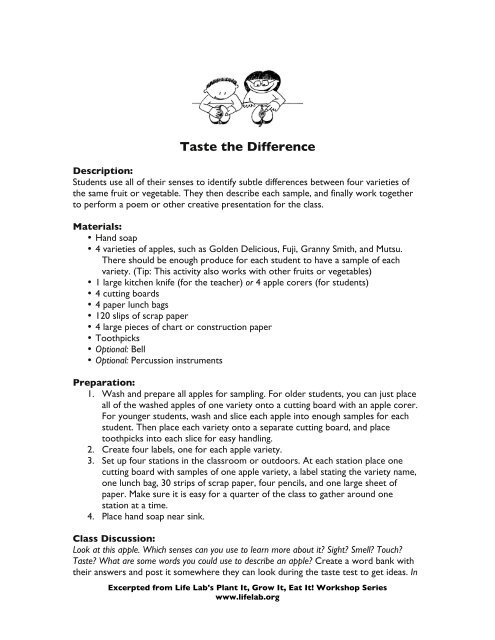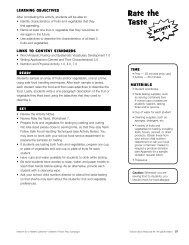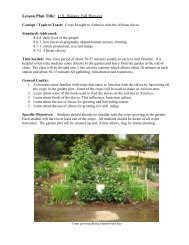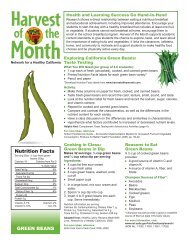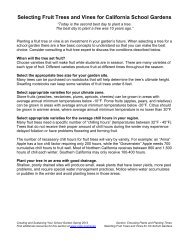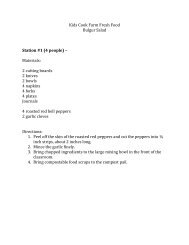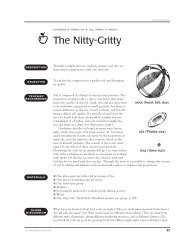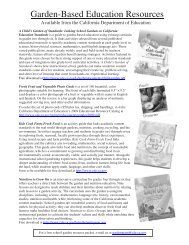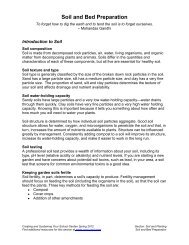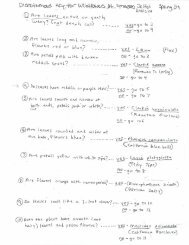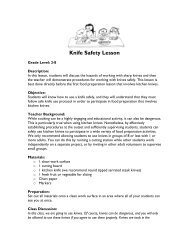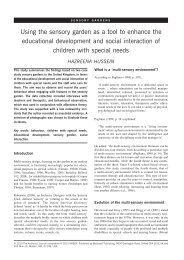Taste The Difference Activity.pdf - Life Lab
Taste The Difference Activity.pdf - Life Lab
Taste The Difference Activity.pdf - Life Lab
- No tags were found...
You also want an ePaper? Increase the reach of your titles
YUMPU automatically turns print PDFs into web optimized ePapers that Google loves.
<strong>Taste</strong> the <strong>Difference</strong>Description:Students use all of their senses to identify subtle differences between four varieties ofthe same fruit or vegetable. <strong>The</strong>y then describe each sample, and finally work togetherto perform a poem or other creative presentation for the class.Materials:• Hand soap• 4 varieties of apples, such as Golden Delicious, Fuji, Granny Smith, and Mutsu.<strong>The</strong>re should be enough produce for each student to have a sample of eachvariety. (Tip: This activity also works with other fruits or vegetables)• 1 large kitchen knife (for the teacher) or 4 apple corers (for students)• 4 cutting boards• 4 paper lunch bags• 120 slips of scrap paper• 4 large pieces of chart or construction paper• Toothpicks• Optional: Bell• Optional: Percussion instrumentsPreparation:1. Wash and prepare all apples for sampling. For older students, you can just placeall of the washed apples of one variety onto a cutting board with an apple corer.For younger students, wash and slice each apple into enough samples for eachstudent. <strong>The</strong>n place each variety onto a separate cutting board, and placetoothpicks into each slice for easy handling.2. Create four labels, one for each apple variety.3. Set up four stations in the classroom or outdoors. At each station place onecutting board with samples of one apple variety, a label stating the variety name,one lunch bag, 30 strips of scrap paper, four pencils, and one large sheet ofpaper. Make sure it is easy for a quarter of the class to gather around onestation at a time.4. Place hand soap near sink.Class Discussion:Look at this apple. Which senses can you use to learn more about it? Sight? Smell? Touch?<strong>Taste</strong>? What are some words you could use to describe an apple? Create a word bank withtheir answers and post it somewhere they can look during the taste test to get ideas. InExcerpted from <strong>Life</strong> <strong>Lab</strong>'s Plant It, Grow It, Eat It! Workshop Serieswww.lifelab.org
this lesson there are four stations with four different types of apples; you will spend a fewminutes at each station. If relevant at this point, demonstrate how to use an apple corer.Each of you will examine very closely one slice of apple at each station. Be sure to notice thecolors on the inside and outside and the smell. <strong>The</strong>n taste your apple slice, and notice the flavorand texture (that's the way it feels) inside your mouth. Finally, each of you will choose a word todescribe the apple at the station, write the word on a strip of paper, and put the paper in thelunch bag. Demonstrate the process. When you hear me ring this bell, rotate clockwise tothe next station. Again, demonstrate.Action:1. Discuss or review safe food handling. Highlight and demonstrate how to washhands thoroughly and how to take a sample without touching any of the othersamples on the plate.2. Have all students wash their hands.3. Divide the class into four groups. Each group will spend a few minutes at eachapple station, exploring and tasting each sample. Suggest that they use all of theirsenses to observe what makes that apple variety unique.4. At each station, ask each student to write on a strip of paper one descriptiveword about the sample and place it in the bag.5. After the groups have been to all stations, have them return to the stationwhere they started and open the bag of words. Have each group use all thewords to compose a poem about that apple variety. Ask them to copy it ontothe large sheet of paper. Each word must be used once; if the same wordappears three times, it must be used three times. Encourage creativity; studentscan act out their poem, turn it into a song, or even choreograph it as a dance.<strong>The</strong>y can choose the order of the words, the rhythm, and whether or not toinclude gestures, percussion instruments, audience participation, or handclapping. Have the students title their poems.6. Have each group present their poem to the class. After each one, the class cantry to guess which apple variety that group had.7. Post the poems and attach the apple variety name to each one.Digging Deeper:Which apple was the most sweet? Tart? Crunchy? Juicy? Compare two apples thatseemed very different from each other. Compare the two apples that seemed the mostsimilar.In the fall, visit an apple orchard to see apples growing on trees, or visit a farmers'market to meet an apple farmer and taste even more varieties of apples.California Health Standards:7.1.N. Select nutritious snacks.1.6.G. Name and describe the five sense.1.6.N. Describe how to keep food safe from harmful germs.Excerpted from <strong>Life</strong> <strong>Lab</strong>'s Plant It, Grow It, Eat It! Workshop Serieswww.lifelab.org


